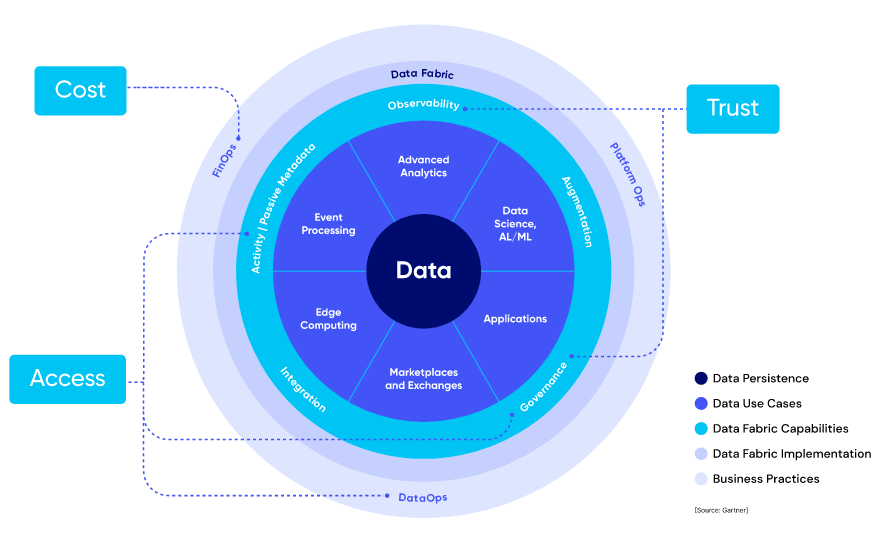Data is a corporate asset that businesses can leverage to improve business objectives, goals and initiatives on day-to-day operations, and ultimately boost revenue and profits.
However, poor data management can cause organizations to struggle with incompatible data silos, conflicting data sets, and data quality issues, making it difficult for them to create a single source of truth without inconsistencies, run business intelligence (BI) and analytic applications or, worse, produce inaccurate results.
Data management has become more crucial as organizations must comply with more regulations, especially data privacy and protection of laws like the GDPR in the EU (or the CCPA in the US). Additionally, businesses are collecting larger amounts of data from a wide range of sources, which can become challenging to traverse without effective data management.
This blog will discuss data management disciplines, best practices for managing data, problems that organizations must overcome, and the financial advantages of an effective data management strategy.
What is Data Management?
Data management is the process of storing, organizing, and preserving the data generated and collected by an organization. It is a key component of IT systems within businesses, and it helps deliver analytical data to support operational decision-making and strategic planning by "data users" (heads of data, data engineers, analytics engineers, data analysts, data scientists) and "business users" (sales, marketing, finance, customer success, and other end-users).
The goal of the data management process, which combines several distinct tasks, is to guarantee that the data stored in business systems is reliable (quality of data), accessible (governance of data), and* up-to-date* (availability of data).
Key Components of Data Management
Here are a few components of the overall data management process:
● Developing a data architecture: This is often the first step, particularly in large organizations with lots of data to manage. A data architecture provides a blueprint for managing data and deploying databases and other data platforms, including specific technologies to fit individual applications.
● The right database: The most common form used to hold corporate data is via databases. These are helpful in both transaction processing systems that create operational data, such as customer records and sales orders, and data warehouses, which store and compute upon consolidated data sets from business systems for BI and analytics.
● Performance monitoring: This involves periodically reviewing your database to find visibility gaps, alert potential problems, monitor slow queries, and more.
● Database administration: Relates to database design, configuration, installation, and updates; data security; database backup and recovery; and software upgrades and security patches.
● Data governance: Putting together procedures, responsibilities, rules, standards, and measurements required to safeguard data assets by making every team member responsible for data governance. This collaborative and distributed approach ensures that enterprise-level visibility and common policies lead to better data reliability, accuracy and security.
● Data quality and observability: Identifying duplicates, missing records and other inconsistencies to guarantee you're overseeing the correct data that has been verified and ready for analysis.
● Data modeling: You can depict the relationships between data elements and how data flows through systems using data modeling.
What are the benefits of data management?
● Scalability: Businesses can avoid duplication and labor costs by maximizing the efficiency of their data management.
● Better visibility over data: Business analysts can follow data jobs and processes to monitor key performance indicators (KPIs) via BI querying and enterprise reporting, which are the main use cases for transformations running inside data warehouses.
● Analytics capabilities: Effective data management gives data scientists visibility over all assets, so they can use the right data in dashboards built for reporting and analytics purposes.
● Reliability: Using techniques like change data capture (CDC) and streaming data integration, data management teams can perform real-time data integration and ensure they have reliable and most updated data.
[
](https://www.slideteam.net/big-data-it-benefits-of-big-data-management-for-business.html)
Four Essential Tips for Data Management
The following best practices will help your data management process stay on track:
1. Prioritizing Compliance and Security
Effective data management strategies must incorporate a solid data governance program, especially in companies with distributed data environments comprising various systems. It's worth noting that IT and data management teams can't always handle data quality and governance on their own, especially as data security becomes increasingly more important in the 21st century.
To comply with data protection regulations and avoid fines, you'll need to ensure that the quality of your data remains top-notch and that everyone from executive to junior levels understands the ins and outs of data privacy.
2. Managing Data Access
Verizon's 2022 Data Breach Incident Report found that 82% of data breaches involve human error, such as phishing attacks or credential theft. The statistics are even worse when remote working is involved, with 20% of organizations admitting they've suffered a breach due to a remote worker or remote working practices.
Although employees don't intentionally put sensitive assets at risk, it still happens. Mitigation strategies include taking a zero trust approach to restrict employees' access to data assets and assigning permissions only to the data they need. For example, you can assign data team users and business users different access privileges based on their responsibilities, authority, and department.
Access control involves two key components: authentication (verifying the user's identity) and authorization (determining the user's level of access). For data access management to work effectively, you'll need to define a strategy, apply it consistently, and make sure every single employee understands what data access management is and how it affects their daily operations.Collaborating with your entire organization and communicating employees' role-based clearance levels also improves data governance.
3. Making Your Data Discoverable
Modern organizations use large volumes of data in different formats across multiple roles and locations, which only makes the subject of discoverability more difficult to navigate. Your organization as a whole needs a single source of truth that all departments can rely on. Without discoverability, users cannot be certain that the data is reliable, accessible, and up-to-date. Siloed and inaccessible data is not only a barrier to productivity, but it often lacks context, meaning that employees and business leaders can't rely on it for effective decision-making.\
Data discovery can easily become a labor-intensive task, which is why data teams use data discovery tools to help clear away the mist. These tools provide the scalability to s*upport increasing data volumes and read requests and give employees visibility over accurate data* in a unified, easy-to-understand format, such as Data Catalog. Advanced data discovery tools have comprehensive tagging and filtering capabilities to deliver quick NLP search results, so you can access the data you need for dashboards, BI and analytics.
4. Selecting the Right Solution for Your Use Cases
You can get much-needed assistance in gaining visibility over all your data, tech stack, and additional technologies from a single data management software. While it might take some time to research the right one for your business, it is worth the evaluation effort, as data management software brings together all your data pipeline in one place.
Data management platforms like Aggua provide data teams with an all-in-one view of your data flow and centralize catalog, lineage, cost metrics, governance, observability, and more. Aggua enables you to see all changes to your data, who made them, and when they occurred to provide complete visibility over your data as a single source of truth.
[
](https://community.microfocus.com/cyberres/b/sws-22/posts/what-is-the-big-deal-about-data-discovery)
Aggua: Enhancing Visibility Over Data Management
By enhancing operational effectiveness and facilitating improved decision-making, a data management strategy can assist organizations in gaining a competitive advantage in their industry.\
Well-managed data may help organizations become more efficient, flexible and enable them to recognize market trends and act more rapidly to seize new business opportunities. A high level of data management helps transform organizations into data-driven entities that better leverage their data and analytics to move at speed of light towards their business goals.









Top comments (0)